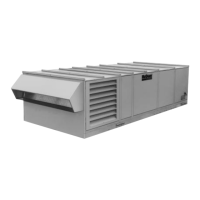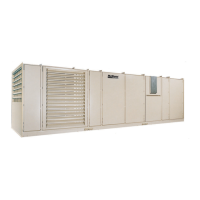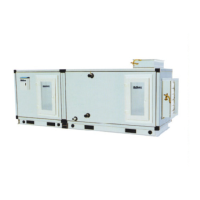IM-738 Page 93
Maintenance
Preventive Maintenance
Preventive maintenance is the best way to avoid unnecessary
expense and inconvenience. Have this system inspected at reg-
ular intervals by a qualified service technician. The required
frequency of inspections depends upon the total operating time
and the indoor and outdoor environmental conditions. Routine
maintenance should cover the following items:
1. Tighten all belts, wire connections, and setscrews.
2. Clean the evaporator and condenser coils mechanically or
with cold water, if necessary. Usually any fouling is only
matted on the entering air face of the coil and can be
removed by brushing.
3. Lubricate the motor and fan shaft bearings.
4. Align or replace the belts as needed.
5. Clean or replace the filters as needed.
6. Check each circuit's refrigerant sightglass when the circuit
is operating under steady-state, full load conditions. The
sightglass should then be full and clear. If it is not, check
for refrigerant leaks.
Note: A partially full sight glass is not uncommon at
part load conditions.
7. Check for proper superheat.
See “Checking Superheat” on page 80.
8. Check for blockage of the condensate drain. Clean the
condensate pan as needed.
9. Check the power and control voltages.
10.Check the running amperage of all motors.
11.Check all operating temperatures and pressures.
12.Check and adjust all temperature and pressure controls
as needed.
13.Check and adjust all damper linkages as needed.
14.Check the operation of all safety controls.
15.Examine the gas furnace (see Bulletin No. IM 684 or685).
16.Check the condenser fans and tighten their setscrews.
17.Lubricate the door latch mechanisms.
Unit Storage
Location
The McQuay Rooftop Packaged System Unit is an outdoor
unit. However, the schedule may dictate storage either on the
ground or in its final position at the site. If the unit is stored on
the ground, additional precautions should be taken as follows:
1. Make sure that the unit is well supported along the length
of the base rail.
2. Make sure that the unit is level (no twists or uneven ground
surface).
3. Provide proper drainage around the unit to prevent flood-
ing of the equipment
4. Provide adequate protection from vandalism, mechanical
contact, etc. The condenser fins are particularly vulnerable
to damage by even light contact with ground based objects.
5. Provide unit doors are securely closed.
6. If isolation dampers are provided, verify that they are prop-
erly installed and fully closed to prevent the entry of ani-
mals and debris through the supply and return air openings.
7. Units without isolation dampers should be fitted with cov-
ers over the supply and return air openings.
Preparation
Supply (and Return) fans
1. Move the motor base to check and lubricate slides and
leadscrews.
2. Remove the drive belts, tag them with the fan name and
unit serial number and store them in a conditioned space
out of direct sunlight.
3. Once every two weeks, rotate the fan and motor shafts.
Mark the shaft positions fIrst to make sure they stop in a
different position.
4. Depending on local climatic conditions, condensate ~ col-
lect on components inside the units. To prevent surface
rust and discoloration, spray all bare metal parts with a
rust preventive compound. Pay close attention to fan
shafts, sheaves, bearings and bearing supports,
Cabinet Sections
1. Once a month, open a door on each section and verify that
no moisture or debris is accumulating in the unit.
Cooling circuits
1. Provide that each circuit is properly pumped down.
2. Pull the fuses to each compressor
(store them in the control cabinet)
3. Close all the refrigerant service valves on each circuit
Installation and maintenance are to be performed
only by qualified personnel who are experienced
with this type of equipment and familiar with local
codes and regulations.
WARNING
Moving machinery and electrical power hazards.
May cause severe personal injury or death.
Disconnect and lock off power before servicing
equipment.
CAUTION
Sharp edges are inherent to sheet metal parts,
screws, clips, and similar items. May cause
personal injury.
Exercise caution when servicing equipment.

